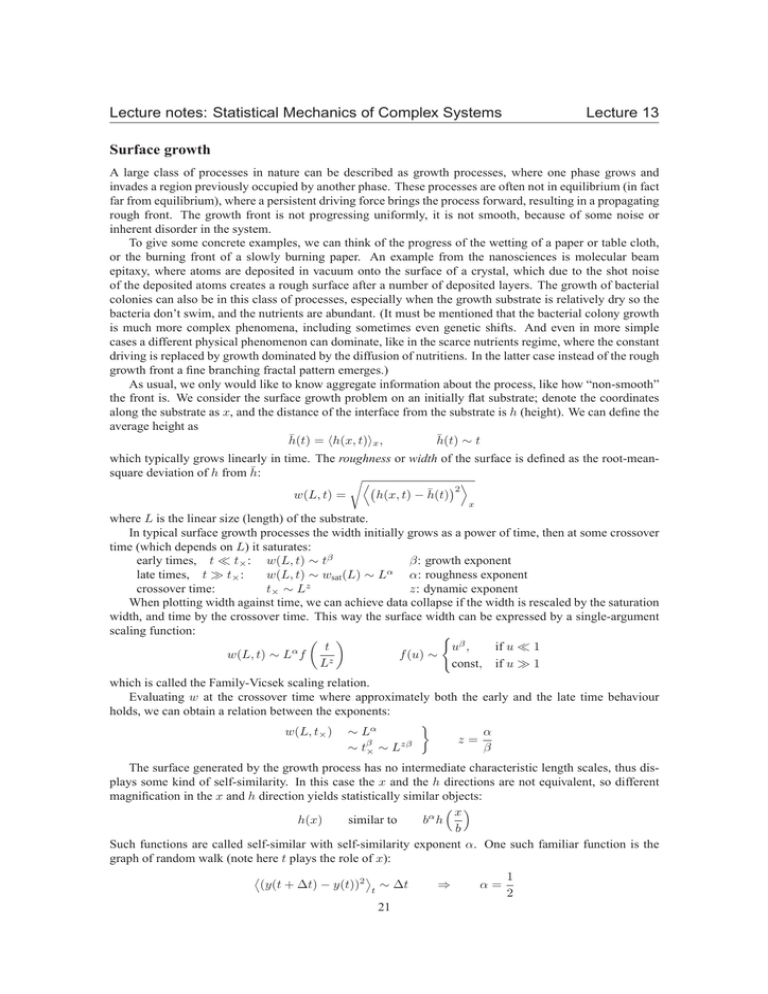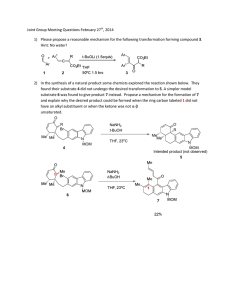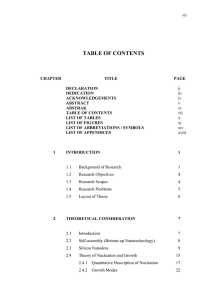Lecture notes: Statistical Mechanics of Complex Systems Lecture 13 Surface growth
advertisement

Lecture notes: Statistical Mechanics of Complex Systems Lecture 13 Surface growth A large class of processes in nature can be described as growth processes, where one phase grows and invades a region previously occupied by another phase. These processes are often not in equilibrium (in fact far from equilibrium), where a persistent driving force brings the process forward, resulting in a propagating rough front. The growth front is not progressing uniformly, it is not smooth, because of some noise or inherent disorder in the system. To give some concrete examples, we can think of the progress of the wetting of a paper or table cloth, or the burning front of a slowly burning paper. An example from the nanosciences is molecular beam epitaxy, where atoms are deposited in vacuum onto the surface of a crystal, which due to the shot noise of the deposited atoms creates a rough surface after a number of deposited layers. The growth of bacterial colonies can also be in this class of processes, especially when the growth substrate is relatively dry so the bacteria don’t swim, and the nutrients are abundant. (It must be mentioned that the bacterial colony growth is much more complex phenomena, including sometimes even genetic shifts. And even in more simple cases a different physical phenomenon can dominate, like in the scarce nutrients regime, where the constant driving is replaced by growth dominated by the diffusion of nutritiens. In the latter case instead of the rough growth front a fine branching fractal pattern emerges.) As usual, we only would like to know aggregate information about the process, like how “non-smooth” the front is. We consider the surface growth problem on an initially flat substrate; denote the coordinates along the substrate as x, and the distance of the interface from the substrate is h (height). We can define the average height as h̄(t) = hh(x, t)ix , h̄(t) ∼ t which typically grows linearly in time. The roughness or width of the surface is defined as the root-meansquare deviation of h from h̄: rD 2 E w(L, t) = h(x, t) − h̄(t) x where L is the linear size (length) of the substrate. In typical surface growth processes the width initially grows as a power of time, then at some crossover time (which depends on L) it saturates: early times, t ≪ t× : w(L, t) ∼ tβ β: growth exponent late times, t ≫ t× : w(L, t) ∼ wsat (L) ∼ Lα α: roughness exponent crossover time: t× ∼ Lz z: dynamic exponent When plotting width against time, we can achieve data collapse if the width is rescaled by the saturation width, and time by the crossover time. This way the surface width can be expressed by a single-argument scaling function: ( uβ , if u ≪ 1 t α f (u) ∼ w(L, t) ∼ L f z L const, if u ≫ 1 which is called the Family-Vicsek scaling relation. Evaluating w at the crossover time where approximately both the early and the late time behaviour holds, we can obtain a relation between the exponents: α w(L, t× ) ∼ Lα z= β zβ ∼ t× ∼ L β The surface generated by the growth process has no intermediate characteristic length scales, thus displays some kind of self-similarity. In this case the x and the h directions are not equivalent, so different magnification in the x and h direction yields statistically similar objects: x h(x) similar to bα h b Such functions are called self-similar with self-similarity exponent α. One such familiar function is the graph of random walk (note here t plays the role of x): 1 (y(t + ∆t) − y(t))2 t ∼ ∆t ⇒ α= 2 21 Lecture notes: Statistical Mechanics of Complex Systems Lecture 13 These surface growth processes can be illustrated by simple models, for example: • random deposition: unit square blocks are released above integer positions of a substrate, and they just land on top of previously dropped blocks. For this model α is undefined, and β = 1/2. • random deposition with surface relaxation: as for random deposition, but the blocks are allowed to jump to the nearest neighbor substrate position to achieve lowest position. • restricted solid-on-solid (RSOS) model: only those growth events are allowed which keep local slope bounded: maintain |h(x) − h(x + 1)| ≤ 1 Another approach to understand the surface growth processes is to consider continuum equations: ∂h = G[h(·), x, t] + η ∂t where the noise term is often unbiased and delta-correlated: eg. η(x, t) : hη(x, t)i = 0, hη(x, t)η(x′ , t′ )i = 2Dδ(x − x′ )δ(t − t′ ) These equations have the following desired symmetries: t → t + ∆t h → h + ∆h x → x + ∆x x → −x, or rotation h → −h (in certain cases, eg. if in equilibrium) The simplest such equation is the Edwards-Wilkinson equation: ∂h = ∇2 h + η(x, t) ∂t d α=1− , 2 β= 1 d − , 2 4 z=2 The simplest one breaking the h → −h symmetry is the Kardar-Parisi-Zhang (KPZ) equation: λ ∂h = ∇2 h + (∇h)2 + η(x, t) ∂t 2 for d = 1 : α= 1 , 2 β= 1 , 3 z= 3 2 which describes eg. the RSOS model. The continuum equations and discrete models can be classified into equivalence classes (universality classes, as we will see in continuous phase transitions), where the exponents are the same across a class. 22






